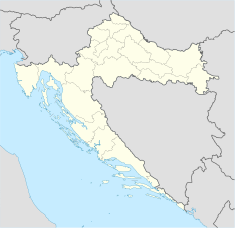Golden Gate (Diocletian's Palace)
| Golden Gate | |
|---|---|
| Native name Roman | |
The Golden Gate (
History
The gate stood at a terminal point of the road which led north towards
Amid the upheavals of the
The sieges of the early Middle Ages prompted the town's inhabitants to close off the gate, using a smaller and more defensible passageway in its place. In more settled times, a new gate, the Door of Picture, permanently superseded the Golden Gate as the main entrance to the city on the north side.
In or around 1630, the Venetian governor Alvise Zorzi ordered the disassembly of eleven Roman towers on the north and east sides of the palace wall, sending the stone blocks to Venice to be used in the construction of Santa Maria della Salute. Among the casualties of this project were the two octagonal towers flanking the Golden Gate.[5] The gate was only re-opened in 1857,[3] in an undertaking which necessitated the demolition of houses which had been built up against the north wall of the palace. Much accumulated earth was cleared away, but around 2 meters of the gate and wall remain below ground level. The most recent reconstruction was carried out by the metropolis in the first years of the new millennium, with the gate covered in a building wrap from 2012 until 2015. As of 2020, the structure was open to the public.
Description
The Porta Septemtrionalis was the "main landward gate" of Diocletian's palace,[6] located in the middle of the northern wall. Its exterior opening measures 4.17 by 4.36 meters; above the lintel is a 3.02-meter-high arch composed of 19 stone blocks.[7] The double doors of the gate were set into this opening, which could also be closed by a portcullis.[8] Between the inner and outer openings of the gate is a courtyard (propugnaculum), once overseen by guard passageways built into its upper walls. The inner gate opens onto the Cardo Maximus, at whose opposite end is the Bronze Gate. Centuries of soil accumulation at the base of the wall have reduced the openings in the gate from 6.5 to fewer than 4.5 meters in height.[3]

Set into the facade of the gate are five niches, two on each side of the central arch and one above. Four of these once housed statues of the Tetrarchs: Diocletian, Maximian, Galerius and Constantius Chlorus.[9] Modern restorers note that the fifth, central niche was made too shallow to hold a statue, to leave room for the portcullis to retract into the upper part of the gate. The same examination found no evidence of statues having stood in the other niches, and the restorers express doubt that the decoration of the gate was ever finished.[10]
The upper three niches are incorporated into a
The outer gate was defended by two
Gallery
-
Reconstruction of the 5th century Porta Aurea
-
View of The Golden Gate ca. 1910, Photo by E. Hébrard and J. Zeiller, Spalato, le Palais de Dioclétien, Paris, 1912.
-
The Porta Aurea, during cleaning and restoration 2007
See also
- Diocletian's Palace
- Vestibule (Split)
- The Bronze Gate (Diocletian's Palace)
- The Iron Gate (Diocletian's Palace)
- The Silver Gate (Diocletian's Palace)
- The Golden Gate (Constantinople), Imperial entrance gate of the city of Constantinople, present-day Istanbul, Turkey
- Red Peristyle (an act of urban intervention done on the main square of the palace)
- Roman architecture
- Marjan, Croatia
- Salona
- Dalmatia
References
- ^ "Zlatna vrata u Splitu".
- ^ Prijatelj 2005, p. 32.
- ^ a b c Prijatelj 2005, p. 33.
- ^ "Is Saint Martin the Narrowest Church You Have Ever Seen?".
- ^ Baras 2010, pp. 42–43.
- ISBN 0-8478-0972-2.)
{{cite book}}: CS1 maint: location (link - ^ Šušnjar 2003, pp. 71–72.
- ^ S2CID 248519582.
- ^ Šušnjar 2003, p. 73.
- ISBN 978-3-11-091460-3.
- ISBN 978-1-84836-472-1.)
{{cite book}}: CS1 maint: location (link - ISBN 978-0-30005-292-3.
- ^ Šušnjar 2003, pp. 56–57.
Further reading
- Baras, Frano (2010). Prohujalo pod marjanom: legende i kronike. OCLC 1240825879.
- Prijatelj, Kruno (2005). Spomenici Splita i okolice. Ex libris. OCLC 191703015.
- Šušnjar, Bogdan (2003). Villa cara Dioklecijana u Splitu. Bošković. OCLC 163413680.
External links
- Zlatna vrata u Splitu - putovnica.net (accessed 23.06.2019.) (in Croatian)
- Zlatna vrata - visitsplit.com (accessed 23.06.2019.) (in Croatian)







